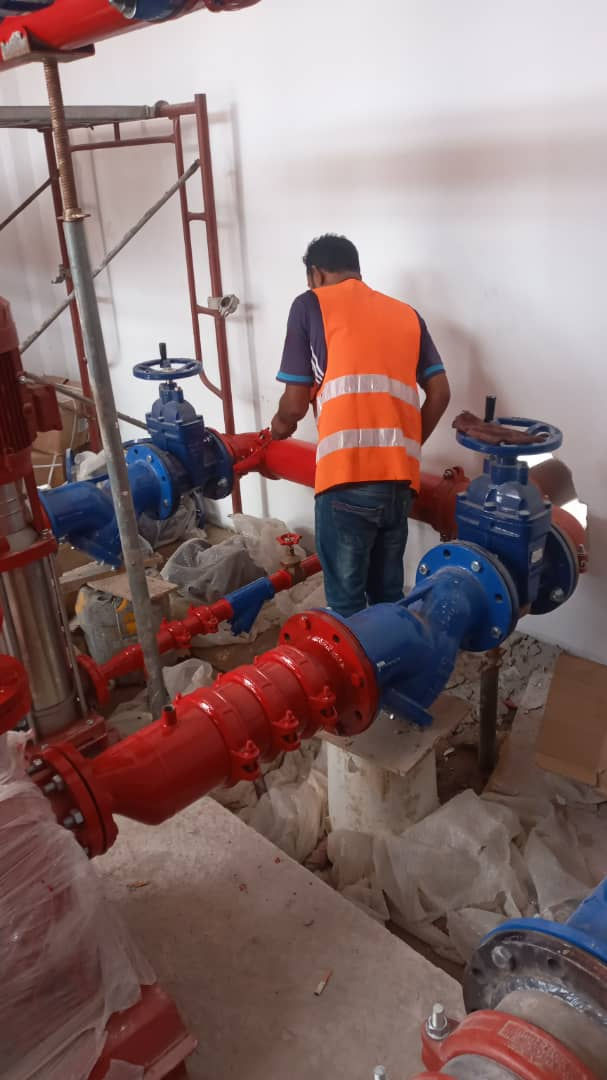Fire Pump Room
- Hegel - Fire Engineering Team
- May 10, 2023
- 3 min read

A fire pump room is a critical component of any building's fire protection system. It houses the fire pump, which is responsible for supplying water to the building's sprinkler system or other fire protection systems during a fire emergency. As such, the design and construction of a fire pump room should be given the utmost attention to ensure that it is effective, safe, and reliable in case of a fire outbreak.
In this blog, we will discuss the essential elements of a fire pump room design, which include location, size, entrance, flooring, walls, ventilation, lighting, fire suppression, clearance, and signage.
1. Location: The location of the fire pump room is critical to its effectiveness. The room should be located close to the main water supply for the building and have easy access for firefighters in case of an emergency. The fire pump room should be situated away from potential hazards like electrical rooms or other flammable materials.

2. Size: The size of the fire pump room is determined by the capacity of the fire pump and the amount of equipment that needs to be housed in the room. The room should be spacious enough to accommodate the fire pump, the electric motor that drives it, and other auxiliary equipment like controllers, backup power supplies, and gauges.
3. Entrance: The entrance to the fire pump room should be wide enough to allow for easy removal and installation of the fire pump and other equipment. It should also have enough clearance to allow for the removal and replacement of large equipment without any difficulty.
4. Flooring: The floor of the fire pump room should be sloped towards a drain to allow for easy removal of any water that may accumulate in the room. The slope should be adequate to ensure that the water drains entirely, leaving no stagnant water. The floor should also be made of materials that are not combustible, waterproof, and corrosion-resistant.

5. Walls: The walls of the fire pump room should be made of materials that are not combustible and should be fire-rated to prevent the spread of fire. The thickness of the walls will depend on the type of fire protection system in place, the size of the fire pump, and the equipment housed in the room.
6. Ventilation: The fire pump room should be adequately ventilated to prevent the buildup of heat and fumes from the fire pump. This is essential to keep the temperature in the room at a safe level and prevent the buildup of toxic gases. The ventilation system should be designed to ensure that the room has sufficient airflow to keep the room cool, prevent moisture buildup and remove fumes.
7. Lighting: The fire pump room should be adequately illuminated to allow for easy maintenance and inspection of the fire pump and other equipment. The lighting should be bright enough to allow the fire pump to be seen clearly and should be placed in such a way that it does not create any shadows or dark spots.

8. Fire suppression: The fire pump room should be protected by an automatic fire suppression system, such as a clean agent system. This system should be able to detect and suppress fires quickly, minimizing the risk of damage to the fire pump and other equipment.
9. Clearance: Sufficient clearance should be provided around the fire pump and other equipment to allow for easy access for maintenance and inspection. There should be enough space around the fire pump to ensure that it can be serviced or replaced easily without interfering with other equipment in the room.
10. Signage: Appropriate signage should be installed to indicate the location of the fire pump room and the location of the fire pump switch. The signage should be highly visible, and the location of the switch should be easy to find, even in low light conditions.
Designing a fire pump room requires careful consideration of the critical elements discussed above. A well-designed fire pump room can provide the necessary




































UP Manav Sampada is a revolutionary digital step, successfully centralizing employee records, thereby ending the reliance on physical paperwork. This essential e-HRMS platform allows over 1.7 million government employees to digitally manage their service history, a huge boost for administrative efficiency and transparency across all departments in Uttar Pradesh.
Hokkoo Escorts Call Girl Agency offer a wide selection of Hot Sexy VIP Escorts for incall service with free hotel rooms 24 7 come to Our Reliable & Trusted Escorts Agency, the best and most well-known Bhopal Call Girl. We always offer 50% off our call girls services. Cash Payment is Available. Our Call Girl Agency are popular with people who enjoy having fun. They like beautiful partners and stay out all night.
This article gives a detailed view of how crucial a fire pump room’s design is for safety and efficiency. Every aspect—from ventilation to fire suppression—shows the importance of precision. It reminds me of how maintaining outdoor safety also matters, like keeping areas clear with a reliable Brush Chipping Service near me to prevent fire hazards.
The game app is available to “download” and has easily been installed in devices like Android and IOs. The Betpkr game download offers a variety of games to users with digital money.
The field of hypnotherapy is vast. This article touches on advanced hypnotherapy techniques for deeper issues. Finding practitioners skilled in these methods is important. It's great that Radical Online Therapy potentially offers such expertise online, complementing their life coaching, weight loss support, and past life regression services.